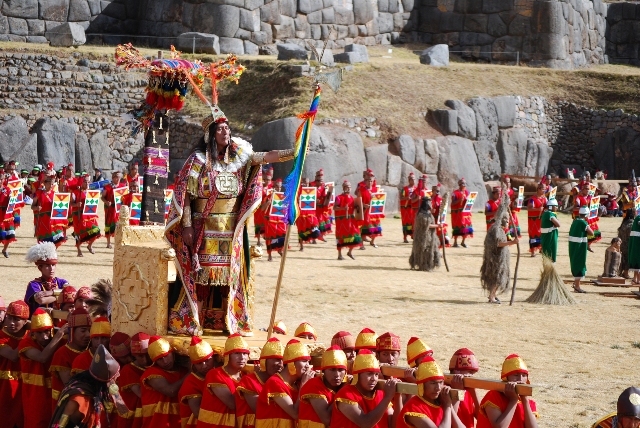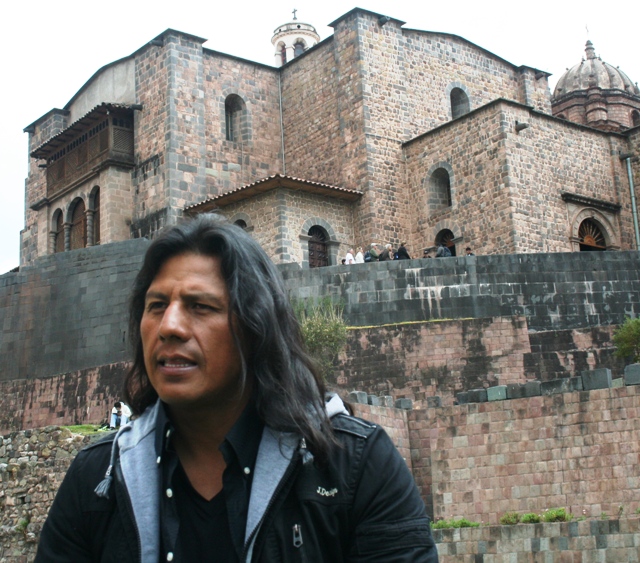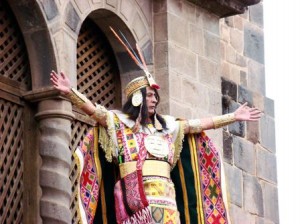For the Inti Raymi event, a cast of hundreds dress in full regalia to welcome the return of the Father Sun, or “Inti”. No deity was more important to the Incas.
The day is filled with music, parades, dances and ceremonies in the ancient Quechua tongue. The festival culminates in the fortress temple ruins of Sacsayhuaman in the hills above the city of Cusco.
The lead role of Inti Raymi is the Inca, the supreme ruler of the Incan Empire, carried around on a litter. In regal dress of red and gold, he leads the ceremony with gestures and incantations to the sun.
The origins of Inti Raymi
Inti Raymi’s roots run deep. At the height of the Incan empire in the 15th century, over 50,000 people would gather in Cusco to celebrate the festival. Then, with the arrival of the Spanish conquistadores in the 16th century, the great empire began to crumble and Catholicism was declared the official faith. The Incas tried to disguise their festival by moving the date from the true solstice on June 21st to the new date of June 24th, so as to coincide with the Christian feast of San Juan. Yet in 1572 the Spanish officially forbade the festival, and it died out – at least for several centuries.
Inti Raymi was revived in the 1940s, when a Peruvian academic named Faustino Espinoza Navarro laboriously translated colonial documentation of the celebration from Spanish to the original Quechua into a script. Faustino cast himself in the starring role as the Inca for 12 consecutive years. The festival has been repeated with greater fanfare every year since.
Meet Nivardo Carrillo, local actor and music artist
Casting for Inti Raymi is a complex year-long process with many hopefuls for each role. Southwind Adventures has had the unique opportunity to interview Nivardo Carrillo, the starring Inca of the Inti Raymi festival in 2012 as well as in 2007, 2008, and 2011. He is also the uncle of one of our Cusco guides.Southwind: Tell us a little about your background. Where are you from? How did you enter the world of performing arts?
Nivardo Carrillo: I was born in the province of Chumbivilcas, to the southwest of Cusco, in the town of Santo Tomas. At age 16, I went to the cities of Arequipa and Lima to pursue my theater studies. I got started in the art world at a very young age. I would even say since the womb of my mother, who is a singer. I’ve dedicated my whole life to learning music, theater, singing, and the performing arts.
Today, I’m married with two children, Esmeralda and Amaru. My children both study music, and Amaru likes to imitate whatever I do. Esmeralda’s the same way. My wife feels very proud of the work I do.

SWA: You’re most well-known for your appearance in the music video “Hoy” with Gloria Estefan, filmed at Machu Picchu and Cusco. How do you feel about that role?
NC: We filmed for 27 days to produce that five minute music video. It shows. Every scene and every location has an extraordinary sense to it. It was a very professional job that taught me how film technology combines with humans, geography, locations, and history. It was an honor to be able to represent a person from my homeland of Cusco. I felt my culture being grasped by singers like Gloria Estefan, and that is the effect of a place like Cusco and Peru in general. I feel so proud.
SWA: We’ve seen on YouTube that you’re a singer-songwriter. What inspires your music?
NC: There are certain parts of living that I feel compelled to transcribe into songs. I’ve experienced so much friendship, so much love, so much life, so much journeying … I transcribe what I’ve lived into music. My brother Oscar is an impassioned songwriter as well.
The last song I wrote is called Bandurria, which is a homage to this pure and sacred instrument. Piquicha is a love song that brings me very fond and special memories.
SWA: Tell us a little about how you came to personify the Inca for the past four Inti Raymi festivals. Did you have to pass an audition or test?
NC: I’ve had to pass tests of all kinds – physical, spiritual, psychological, and intellectual. The municipality of Cusco sets out to find the ideal character that will strengthen our identity. To talk about the Inca is an entire process – extraordinary, beautiful, careful, and spiritual. The Inca’s character is filled with magic and I have to believe it in order to convey it. It takes five or six months of work to prepare. The role is not about resembling the Inca; rather, it’s about being the Inca and representing Cusco, our culture, and our ancestors.
SWA: How do you feel when you personify the Inca?
NC: To me, personifying the Inca is a process of giving what I have, of loving what I have, and dedicating every day to preparation for the role. Every day, I strive to be the Inca. I strive to be more human and more authentic.
I feel proud, I feel happy, I feel reasonable because I come from a grand human culture. I come from an incredible culture of reciprocity, integration, and adaptive solutions. I come from a culture of extremes and of potential. It’s a living culture that still sings its roots. I feel more and more proud each day.
SWA: Do people recognize you in the streets?
NC: Some people do recognize me in public, but I go out very little. In some places, the kids get way too excited. It is children who recognize me, more so than adults. I love sharing my image with children. Young people are the present of this country and this recognition from them makes me much more of an explorer of my own culture.
SWA: To you, what part of the Inti Raymi script is the most evocative?
NC: For me, the best part is the main ceremony at Sacsayhuaman when the Inca speaks to the sun, saying “Father of us all, draw us to your side. Listen to us. Bless us. Drive us down the correct life path. Powerful god, you are the one who carries the life of men in this new beginning and at the end. Never forget us; we are in your hands. Grant us always a pleasant and soft existence.” It’s a very spiritual communication with the stars, charged with hope.
SWA: What do you think about the comments that you have the traits and build of an authentic descendant of the Incas?
NC: I’ve been told that I look a lot like an Inca and I’ve been compared to characters of different books and paintings. I’ve been photographed by big companies and asked for interviews. It leads me to believe that I’m the face of the Incas. With this persona, I want to strengthen our cultural identity. It’s a great honor, but with it comes great responsibility. I live for my country and my people. I sing for my people.
Read more about the history of Inti Raymi
Join Southwind Adventures for Inti Raymi!
The following trips have special Inti Raymi departures:
World of the Incas
Southern Highlights Tour
Inca Trail to Machu Picchu
Manu Rainforest Adventure
Highlands Heritage Tour


